 |
|
|
|
|
Animales
and particularely reptiles have allways been my biggest interest.I am
now 43 years old, and have kept reptiles since I was 12 years old.As
most I started with a lot of different animales, like one turtle, two
spiders and a cornsnake.The last 15 years though, have been dedicated to
the wonderful lizards of the genus Phelsuma.
Even if the species do look similar, they come from very different
altitudes and habitats. That makes them a challenge for any
Herpetologist, new to the hobby or experienced. For us, this is the most
fantastic hobby of all. |
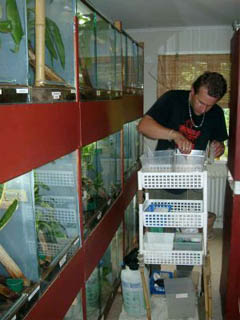
|
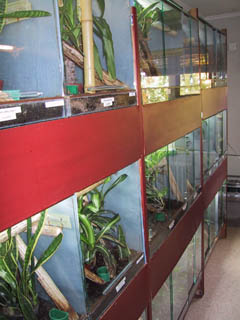
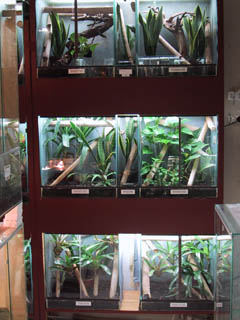 |
Our goals
One is of course to learn moore about these animales. Each specie
have there own unique behavior and needs.Studying these animales in the
wild and in captive care, will provide us with the information that we
need to save these lizards for future generations to come. The most
important goal of all is to be able to provide seriously interested
hobbyists, Zoo´s and institutions with captive bred animales. Over the
years thousands and thousands of wild caught Phelsumas have been
exported, and this together with the destruction of natural habitats,
many species are now at the edge of extinction. A future goal and
dream would be to have a worldwide database, runed by a selected group
of breeders. This database should hold information on bloodlines and
breedingresults. All hatchlings produced would get there own id-number.
Behind this id you should be able to find all neccesary information
about this animal. This would be the only way to maintaine a stable
population of captive bred animales for the hobby in the future.We no
longer can or should depend on wildcaught animales to get fresh
bloodlines or cheep animales for the pet trade. It would also be one way
to show the public that there are people keeping reptiles, that are
seriously interested in the future of
there hobby and the animales involved.
|
|
Projects
During year 2000 we were contacted by Mr. Richard Gibson at Jersey Zoo,
regarding a planned breedingproject with Phelsuma klemmeri. The plan was
to at first involve 6 Zoo:s in a closed studbook program with this
specie. Each Zoo would obtain two pairs from as many different
bloodlines as possible. That made a total of 24 animales needed. Our job
was to convince privat breeders to donate
animales for the project. In early spring 2001, 24 animales were
sent to Tim Skelton at Bristol Zoo gardens. Half of these were donated
by us, and the other half came from breeders within Interessengruppe
Phelsuma ( see link page). From Bristol and Tim ( who works as project
coordinator) two pairs each was sent to London Zoo, Manchester Museum,
Jersey Zoo, Chester Zoo and
Paignton Zoo. This year some of the specimens have started to
produce offspring. These will in the future be placed at other Zoo:s and
institutions that wants to take part in the project. |
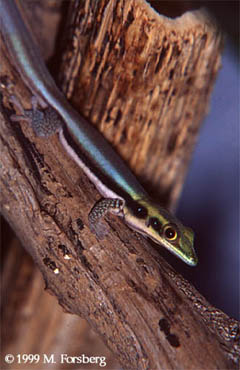
|
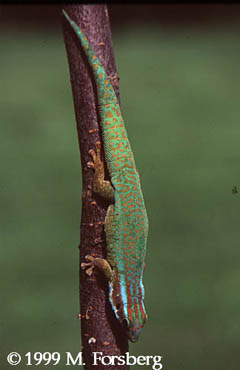
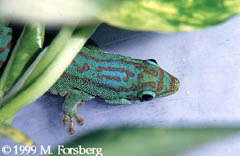 |
Breedingprojects:
Two of the rarest Phelsumas in both the wild and in captivity are
Phelsuma inexpectata and Phelsuma guimbeaui rosagularis. Only a small
group of animales exist in captive care. Together with two German
breeders who together with us keep these species, big efforts have been
made to build up a stable population that regularily produce offspring.
The original animales that was wildcaught was very hard to maintain and
gave very few offspring. Today we have F3 animales. Captive bred
animales from generation F1-F3 have proven to be easier to keep and they
also breed moore regularily. Normally a female produce 6-9 eggs between
april and september. Today we have a population of 12 adults from
P.inexpectata and 15 from P.guim.rosagularis. There still is one problem
to solve, and that is the fact that it is very hard to hatch males from
both species. Very few males are hatched no matter the
incubationtemperature. Lots of experiments on
different temperatures have been made, including both constant and
flucturating temps. I hope that we in the future will be able to produce
both males and females in order to give moore serious breeders the
chance to keep and breed these wonderful Phelsumas.
|
|
|
|
|
|
|
Copyright
© 2002-2008. Magnus Forsberg Sweden. |






